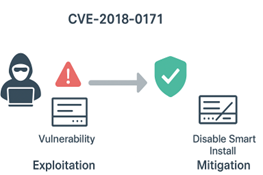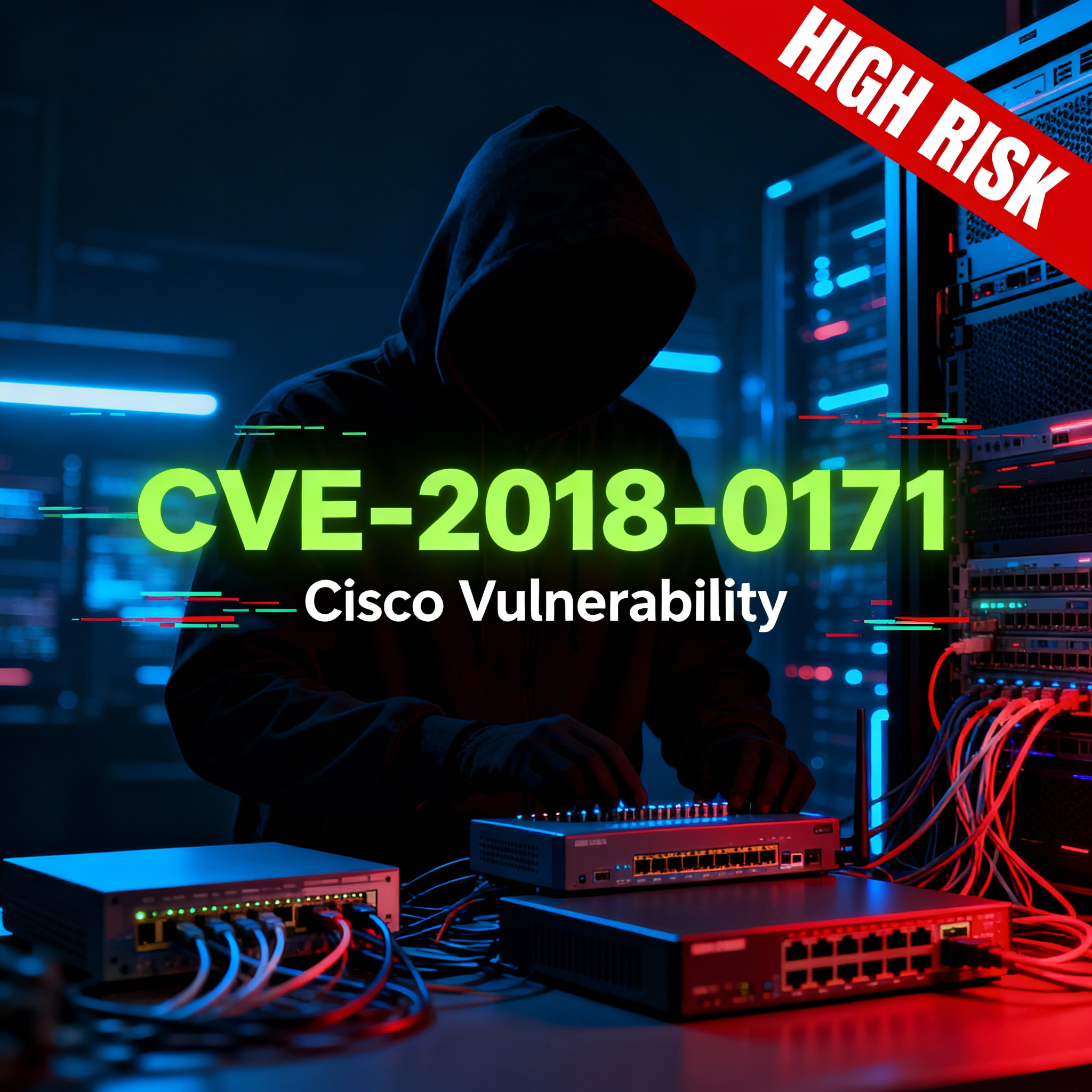Understanding CVE-2018-0171: A Persistent Threat to Network Infrastructure
1. The Nature and Exploitation of CVE-2018-0171

1.1 What Is CVE-2018-0171?
CVE-2018-0171 is a critical remote code execution (RCE) vulnerability affecting Cisco’s Smart Install feature, which is part of the IOS and IOS XE software platforms used in Cisco switches and routers. The flaw results from improper validation of packet data, allowing unauthenticated attackers to send specially crafted Smart Install messages over TCP port 4786.
If successfully exploited, an attacker can trigger a buffer overflow, leading to denial-of-service (DoS) conditions or even full control over the affected device. The vulnerability received a CVSS v3 base score of 9.8, reflecting its critical severity.
Smart Install was designed to simplify network deployment by automatically installing and configuring new switches without manual intervention. However, its default enablement on many devices inadvertently exposed networks to attack, especially when administrators were unaware of its risks (NVD).
1.2 How the Vulnerability Is Exploited
Exploitation of CVE-2018-0171 begins when an attacker identifies a vulnerable device on the network, often using simple scanning tools to detect open TCP port 4786. They then send crafted Smart Install packets designed to overflow memory buffers within the Smart Install client.
Consequences of successful exploitation include:
- Device crash or reload, resulting in temporary denial of service.
- Execution of arbitrary code, potentially giving attackers persistent access.
- Theft of sensitive configuration data, including routing tables, VLAN configurations, and administrative credentials.
The risk is particularly high because Smart Install is often enabled by default on many Cisco devices, meaning even a minimally secured network can be compromised without authentication. Older Cisco devices running software prior to IOS 12.2(52)SE are not affected because they lack the Smart Install feature (Proficio).
1.3 Real-World Exploitation
Despite being disclosed in 2018, CVE-2018-0171 remains actively exploited. For instance, the Static Tundra group, a Russian state-sponsored cyber espionage operation, has repeatedly leveraged this vulnerability to infiltrate networks in multiple sectors: telecommunications, higher education, and manufacturing.
Attackers typically use the vulnerability to:
- Steal configuration files, giving insight into network structure.
- Establish persistent access, allowing long-term surveillance.
- Move laterally within networks, potentially reaching sensitive systems.
Reports have confirmed that unpatched devices, particularly end-of-life switches and routers, remain the primary targets. This real-world activity demonstrates that legacy vulnerabilities can persist for years if not actively managed (Talos Intelligence, Splunk).
2. Mitigation and Defense Strategies
Protecting networks against CVE-2018-0171 requires a multi-layered approach, combining software updates, feature management, network segmentation, and continuous monitoring.
2.1 Applying Cisco’s Security Patches
The most effective way to mitigate CVE-2018-0171 is by upgrading affected devices to patched software versions. Cisco has released updates for all impacted IOS and IOS XE releases.
Administrators should use tools like the Cisco IOS Software Checker to:
- Identify vulnerable devices.
- Verify patch availability.
- Schedule updates during maintenance windows to minimize downtime.
Prompt patching prevents attackers from exploiting the vulnerability while maintaining network performance and security (Proficio).
2.2 Disabling the Smart Install Client Feature
If patching cannot be performed immediately, disabling the Smart Install client provides an effective interim mitigation. Disabling this feature ensures the device no longer listens on TCP port 4786, removing the attack vector.
Cisco provides a safe procedure to disable Smart Install, which involves executing specific commands in the device configuration. While this may limit some automated deployment functionalities, it significantly reduces exposure until patches can be applied (Talos Intelligence).

2.3 Network Segmentation and Monitoring
Beyond patching and feature management, network segmentation is critical. Segmentation separates critical infrastructure (e.g., core routers, data center switches) from less sensitive devices, reducing the risk of lateral movement by attackers.
Additionally, continuous network monitoring allows early detection of malicious activity. Monitoring traffic on TCP port 4786 can reveal unauthorized attempts to exploit Smart Install, enabling rapid incident response before damage occurs.
2.4 Regular Vulnerability Assessments
Ongoing vulnerability assessments are essential to maintaining a secure network environment. Regular scans identify devices with outdated firmware, misconfigurations, or enabled features that could be exploited.
Organizations should also maintain an asset inventory to ensure all network devices are accounted for and updated. Automated tools like the Cisco IOS Software Checker or third-party vulnerability scanners can help streamline this process and reduce human error (Proficio).
Conclusion
CVE-2018-0171 continues to pose a significant threat to network infrastructure due to its high severity and persistent exploitation by advanced threat actors.
Mitigation requires a multi-layered approach:
- Apply software patches immediately.
- Disable unnecessary features like Smart Install.
- Segment networks to contain potential compromises.
- Continuously monitor and assess vulnerabilities.
By combining proactive patching, strict feature management, network monitoring, and regular assessments, organizations can minimize the risk of exploitation and protect critical network assets. Vigilance, ongoing maintenance, and rapid response remain the best defenses against legacy vulnerabilities like CVE-2018-0171.
